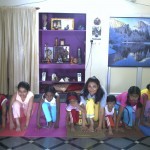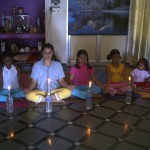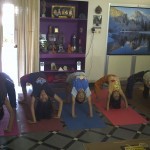 By Dr. Rita Khanna
By Dr. Rita Khanna
Teaching Yoga to children is one of the most delightful experiences. Children are naturally spontaneous, open, and full of imagination. Yoga practices keep these innocent qualities alive in the child. Yoga provides the tools for children to develop into focused, well-balanced, positive, and creative adults. It gives them ways to manage their lives and life situations constructively. It recognizes the interdependence of body, mind, emotions, and spirit and the need for health and balance in all these layers of our being.
Child Development and Yoga
Through Asanas, children learn about their bodies, how to sustain a healthy body, and how to keep it flexible and youthful; indeed, they know co-ordination, although it has been said that this is not fully developed until all the milk teeth are lost. Coordination leads to grace and poise, carried over into other areas of their life and personality.
Through Pranayama practices, children learn to bring about a balanced emotional state. They learn to manage stress, to become aware of agitation and how to deal with it, and to channel their energy creatively. All of this helps to increase their self-confidence and inner stability. The practices of Pratyahara and Dharana give relaxation and discipline, which develop clarity and improve concentration, attention, and memory.
How to Begin Teaching Yoga to Children
When looking for a space to teach Yoga to adults, we look for a place with minimum disturbance to the class. This is not necessarily the case when looking for a place for children to practice Yoga. We need to consider that we should not be disturbing others, as children can be pretty noisy. The space must be clean and clear, free of furniture and other objects. It is helpful if the floor is non-slippery – wooden floors are good. Know where the fire exits, toilets, and telephones are located.
Finding the children:
Decide which age group you wish to teach. It is better to group the children in 5-7 years, 7-9 years, 9-11 years, and so on, as they respond differently to the practices. The teacher’s language needs to change according to the age of the class. Going to schools to offer Yoga classes after school is a good starting point; alternatively, advertising in libraries, health food shops, doctors’ surgeries, etc., brings good results.
Length of class:
For small children, 45 minutes is a good time for a class. Allow time for them to change, take off their shoes and socks, etc. The classes can be longer for older children – one to an hour and a half.
Creating a sacred space:
The classroom can be decorated with posters relating to the theme or topic of the class. Incense and a candle (where appropriate) will increase a sense of uniqueness. It is a good idea to ensure that the children have mats to practice on, and this may mean providing them the same in case they have not brought theirs. With all this and any other props you might need for the class, a helper is a valuable asset. A helper or assistant also gives children individual attention, such as helping them with Asanas or taking them to the toilet.
About Teaching Yoga to Children
 Asana:
Asana:
Children love Asanas, especially animal Asanas, where they can make noises and also learn about the qualities of that animal, and thus, a little more about the world around them. The critical thing in Asana is not to expect perfection; as the child’s awareness increases, the practices will perfect themselves. Yoga with children should be FUN. It should be remembered that a child’s body is still growing until about 17 years; therefore, holding postures is not a good idea. Inverted postures (i.e., headstands) should also be avoided.
Pranayama:
Pranayama practices that are simple and do not involve breath retention are suitable for children. There is a wealth of children’s Yoga books in the market – some geared to teachers and some more appealing to children themselves.
Teaching Yoga Nidra to Children
Yoga nidra is a favorite for children. It should be kept short, as they can relax profoundly and quickly because they tend to be less tense than adults. However, children experience stress from home situations, peer group pressure, exam worries – even world events can worry them, so they need to relax.
 Trataka:
Trataka:
Trataka is another valuable practice for developing concentration memory and quieting the mind. This technique can be done in various ways, including using Mandalas that they may have previously colored and simple Yantras – squares, triangles, etc.
Games:
Games are always successful in a Yoga class, either as ice-breakers, for induction purposes, or as a technique for developing memory and awareness. An example is ‘Kim’s Game,’ where you present the children with a tray of objects they look at for a few minutes; then the tray is covered, and they have to write down everything they can remember.
Another game is the ‘Emotions’ game. A pack of cards is made with different words on each: “I feel happy when . . .”, “I feel sad when . . . “, “I feel frustrated when …” etc. The children choose a card (if they are not happy with it, they can select another) and go on to describe an event or situation that evokes that feeling in them.
It is an excellent way for children to understand and express different emotional states. Stories also go down well. Some Indian comic books telling stories of saints, kings, gods, and goddesses, the Ramayana and Mahabharata, have always been well received.
Themes and topics:
Themes and topics are an excellent tool to plan Yoga classes around – they focus on you and the children and can be repeated for several weeks if successful. (The golden rule in Yoga with children is, “If it isn’t working, drop it immediately!”) These themes can range from a walk in the jungle, a visit to the zoo, the seasons, the elements, festivals like Diwali, and so on.
Themes can also synchronize with topics being covered in school. Equally, one can introduce Yamas and Niyamas. This will introduce children to the philosophy of Yoga and may help in situations like bullying, which is common in schools.
Children learn by example; they are like sponges, and if we set them good examples of behavior, they will imbibe these positive qualities and may bring a positive change to our society.
Teaching Yoga to Children – Discipline
Discipline comes from within; if we enforce it too strongly on children, it will not work. In a Yoga class, the teacher must be in control for safety and effectiveness reasons. So, a simple way to achieve this is to follow the guidelines of Rules, Praise, and Ignore. As the teacher, you set the rules, i.e., this is your mat, and you stay on it unless I ask you to move. Praise the good behavior and ignore the bad as much as possible.
 Generally speaking, you have to do the practices with the students, and young ones especially are too impatient to watch a demonstration – they want to get on with it. I have found that arranging the children in a circle, of which you are a part, is most helpful, as no one can hide at the back, and children are very good at monitoring each other. Disruptive children or those seeking attention can be usefully used as demonstrators, where they are kept busy and have all the attention they need.
Generally speaking, you have to do the practices with the students, and young ones especially are too impatient to watch a demonstration – they want to get on with it. I have found that arranging the children in a circle, of which you are a part, is most helpful, as no one can hide at the back, and children are very good at monitoring each other. Disruptive children or those seeking attention can be usefully used as demonstrators, where they are kept busy and have all the attention they need.
Challenges for Teachers
Firstly, there are challenges with teaching yoga to children. Secondly, it is worth remembering that children do not necessarily want to be in the Yoga class. Sometimes, it is the parent’s wish; therefore, I tend to offer the child the option of not joining in if they don’t want to. Consequently, we have a ‘time-out’ corner for those occasions – a space apart from the others where a child can go to read a book, color a Mandala, or just be.
If we want our children to learn respect, we have to show them respect, so the deal is that the teacher and the group respect the child’s wish not to join in (for any reason). However, the child must appreciate that the rest of us want to practice, so they are to be quiet. It works!
Child protection:
We tend not to use this ‘hands-on’ method of teaching. Make sure you are familiar with safe practices; know any contra-indications or precautions that might be appropriate for children. Make sure they are given BEFORE the practice begins. It is advisable to have an up-to-date first-aid certificate. Always check that you have contact details for the parents or caretakers of each child.
If you feel ready to take up the challenge of teaching Yoga to children, go and do it – even if you have no teaching experience. Your first class will teach you plenty. Go into a local school and offer Yoga classes, do it as seva, get feedback, and keep notes from teachers, parents, and the children themselves. This could be useful for future research projects.
A Note for Parents
If your children do not have this opportunity at school, you can teach them to relax at home, even without ever having practiced these exercises yourself. Adjust the instructions to the child’s level, and do not force his or her attention for more than ten minutes. Here are four exercises inspired by Yoga. Each exercise has a particular quality.
Concentration before the effort:
The first exercise is – keeping the elbows on the table with hands cupped in front of the eyes. Breathe in deeply and slowly breathe out. Practice twelve times. Evoke in the child a landscape or place that he likes. Let him imagine he is there, one with the trees, mountains, sea, or sky.
Attention and imagination:
Place an object in front of the child. Eyes are motionless but without tension. Let him look at the object for 30 seconds. Then, with closed eyes, encourage him to see the object. Then, for a second time, let him look at the object in detail with open eyes.
Teaching Yoga to Children – Inner Peace of Mind
This exercise is based on listening to sounds. Lying, or better, sitting with the back straight and eyes closed. Ask the child to breathe six times, repeating mentally at the same time the word ‘peace’ or ‘relaxation’ at the end of each breath. Then, make him listen to the noises first in the distance, in the street, then in the house, in the room, but without trying to interpret them. A different way to practice for more minor children is to produce three different sounds: crumpled paper, a click of a ballpoint pen, and the sound of a step (when someone walks). Then, ask them in which order the sounds were produced.
Relaxation before sleeping:
With the child lying down, name the different parts of the body that he has to feel without moving. Start with the thumb of the right hand, move up the arm, and then down the right side to the toes. Practice the same way for the left side of the body. Finish with the head. Then, suggest visualization of pleasant pictures to imagine.
Aum Shanti
If you feel inspired by this article, feel free to publish it in your Newsletter or on your Website. Our humble request is to please include the Resource as follows: –
Courtesy: Dr. Rita Khanna’s Yogashaastra Studio.
A famous studio that helps you find natural solutions for complete health.
Mobile: + 919849772485
Ph:-91-40-65173344
Email: yogashaastra@gmail.com
About the Author
Dr. Rita Khanna is a well-known name in Yoga and Naturopathy. She was initiated into this discipline over 25 years ago by the famous Swami Adyatmananda of Sivananda Ashram in Rishikesh (India).
Dr. Rita firmly believes that Yoga is a scientific process that helps us to lead a healthy and disease-free life. She is also actively involved in practicing alternative medicines like Naturopathy. Over the years, she has successfully practiced these therapies and assisted several chronic and terminally ill patients through Yoga, Diet, and Naturopathy. She is also imparting Yoga teacher training.
Dr. Rita Khanna runs a Yoga Studio in Secunderabad (Hyderabad, India).
Are you interested in improving the safety of Yoga classes?
Do you want to become a mindfulness meditation teacher?
Click here to see our online Yoga Nidra teacher training course.
Are you an experienced teacher looking for YACEP credits or continuing education?
Subscribe to Our Newsletter for Special Discounts and New Products
Related Resources
52 Essential Principles of Yoga Philosophy to Deepen Your Practice
by Rina Jakubowicz.
A Relaxing Way to De-stress, Re-energize, and Find Balance
by: Gail Boorstein Grossman.
YOGA: THE PATH TO HOLISTIC HEALTH
by B.K.S. Iyengar
TEACHING YOGA: Essential Foundations and Techniques
By Mark Stephens
Please visit the following link to see our Yoga teacher training and continuing education courses selection.
https://aurawellnesscenter.com/store/
Do you want to become a yoga teacher? See our selection of affordable yoga instructor certification courses.

 Asana:
Asana: Trataka:
Trataka:
If you want to go for a good program of yoga teacher training than you should know that what they are providing in their course. One should aware in finding the difference in their basic and advanced course. To become a great yoga teacher you should have solid foundation and knowledge about basic skills. Here we are offer training programs for yoga teachers with at least 200 hours.
Yoga provides the tools for children to develop into focused, well-balanced, positive, and creative adults. But it should keep in mind that yoga with children should be FUN. Thanks for sharing this nice article!
The classroom can be decorated with posters, relating to the theme or topic of the class and its a good idea to keep children interested in classroom. Thanks for nice posting.